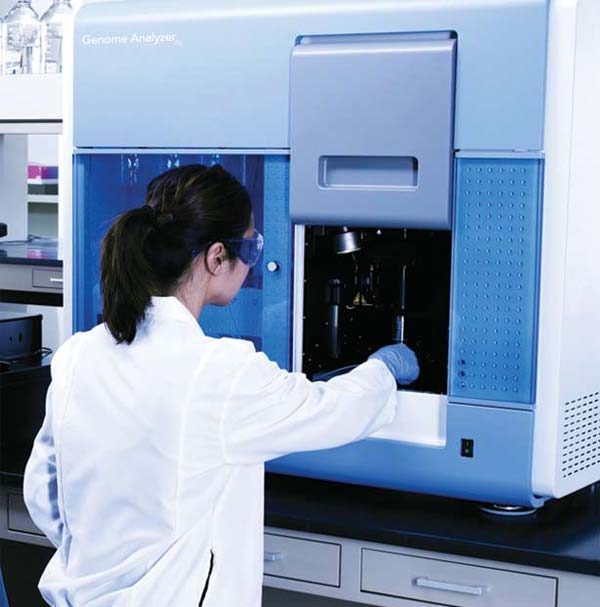Faster Tools to Scrutinize the Genome

The majority of genetic diagnostic testing is done with sequencing, which identifies each base, or “letter,” in a string of DNA. Sequencing can be used to identify all of the roughly three billion base pairs in a human genome, but most clinical testing is limited to sequencing single genes, which can reveal the presence of a mutation that could result in a disease or other disorder. In research, scientists use newer techniques that can scan millions of strands of DNA in parallel–a faster, cheaper process that provides vast amounts of genetic data. But these advanced sequencing tests have yet to be approved or optimized for the practice of medicine.
Most of the fast new sequencing technologies, developed by Illumina, Applied Biosystems, Complete Genomics, and others, use a camera to record fluorescently labeled bases as they bind to bits of a target sample of DNA. Watching a series of these reactions enables software to piece together the DNA sequence. Each company has developed novel ways to densely pack short strands of DNA onto a chip or slide, allowing millions of reactions to be recorded at once (see “Complete Genomics”). Most techniques require DNA molecules to be amplified, or copied many times before sequencing, but even newer methods such as those being developed by Pacific Biosciences and Oxford Nanopore can read the sequence of a single molecule, making it simpler to prepare samples and piece together the sequence.

Another way to scrutinize DNA uses microarrays, chiplike devices that, instead of reading the DNA sequence letter by letter, spot genetic variants known as single-nucleotide polymorphisms (SNPs). Microarrays provide a fast and effective way of screening for a particular variant or pattern of SNPs. Microarray studies have identified hundreds of SNPs that are linked to common diseases. But for the most part, the results have yet to translate into clinical practice. Because such mutations account for only a small percentage of an individual’s overall risk of disease, scientists haven’t yet figured out how to use this information to improve health (see “Drowning in Data”). Researchers are also developing tests for proteins and other biomarkers that reflect how an individuals’ genes interact with the environment.
To date, most advances in personalized medicine have occurred in cancer. For example, genetic screens that sequence portions of genes linked to breast cancer have been available to women with a family history of the disease for over a decade, so that those who carry high-risk variants can be monitored aggressively. Drug makers and scientists have also found genetic markers that predict whether a patient will respond to a given cancer drug, and a few new drugs require accompanying diagnostic tests that use sequencing or microarray technology to profile these markers (see “FDA Takes On Personalized Medicine”).
But so-called pharmacogenetic testing is still limited, especially beyond cancer drugs, not least because most genetic testing must be done in specialized labs and can take weeks. In order to personalize a prescription for someone who has suffered a heart attack, a physician needs information while the patient is still in the hospital. A number of companies are developing desktop devices for use in hospitals, using microarrays that can determine from a drop of blood whether a patient is likely to respond well to a drug. But to truly fulfill the promise of personalized medicine, the advanced sequencing methods in development will need to extend further into clinical practice, making it as easy to read patients’ DNA as it is to send them for x-rays or cholesterol tests.
Keep Reading
Most Popular
Large language models can do jaw-dropping things. But nobody knows exactly why.
And that's a problem. Figuring it out is one of the biggest scientific puzzles of our time and a crucial step towards controlling more powerful future models.
The problem with plug-in hybrids? Their drivers.
Plug-in hybrids are often sold as a transition to EVs, but new data from Europe shows we’re still underestimating the emissions they produce.
Google DeepMind’s new generative model makes Super Mario–like games from scratch
Genie learns how to control games by watching hours and hours of video. It could help train next-gen robots too.
How scientists traced a mysterious covid case back to six toilets
When wastewater surveillance turns into a hunt for a single infected individual, the ethics get tricky.
Stay connected
Get the latest updates from
MIT Technology Review
Discover special offers, top stories, upcoming events, and more.